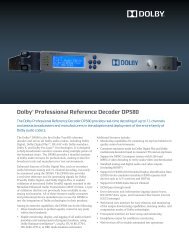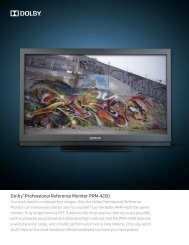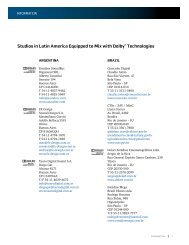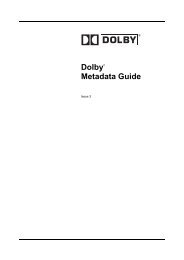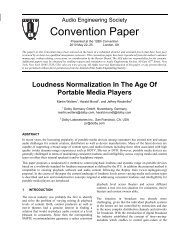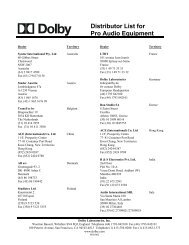Frequently asked QUESTIONS about DOLBY DIGITAL
Frequently asked QUESTIONS about DOLBY DIGITAL
Frequently asked QUESTIONS about DOLBY DIGITAL
You also want an ePaper? Increase the reach of your titles
YUMPU automatically turns print PDFs into web optimized ePapers that Google loves.
<strong>Frequently</strong> Asked Questions<br />
D<br />
olby Digital multichannel<br />
audio is the<br />
next step forward in<br />
sonic realism and<br />
listener involvement. It has<br />
already changed the way you<br />
experience your favorite films in<br />
movie theatres, and is now doing<br />
the same for video programming<br />
at home.<br />
1. What is Dolby Digital?<br />
Dolby Digital is an advanced<br />
form of digital audio coding that<br />
makes it possible to store and<br />
transmit high-quality digital<br />
sound far more efficiently than<br />
was previously possible. First<br />
used in movie theatres in 1992, it<br />
is the result of decades of<br />
experience by Dolby Laboratories<br />
in developing signal processing<br />
systems that exploit the<br />
characteristics of human hearing.<br />
2. What program sources<br />
deliver Dolby Digital<br />
audio?<br />
Dolby Digital audio is available<br />
from laser discs, DVD-Video<br />
discs, DVD-ROM discs for computers,<br />
digital cable systems,<br />
direct broadcast satellite (DBS)<br />
systems, and digital broadcast TV<br />
(DTV). Discs are usually marked<br />
with the logo.<br />
Dolby Digital<br />
program source (DVD<br />
player, DTV receiver,<br />
digital cable box,<br />
etc.)<br />
<strong>about</strong> Dolby Digital<br />
Audio electronics with<br />
Dolby Digital decoding<br />
3. Can I hear Dolby<br />
Digital programs over a<br />
regular stereo or Dolby<br />
Surround Pro Logic<br />
system?<br />
Yes, you can use most of the<br />
new Dolby Digital program<br />
sources with your current playback<br />
system, because they have<br />
Dolby Digital decoders built in to<br />
provide conventional analog<br />
stereo outputs.<br />
However, to experience the<br />
thrilling 5.1-channel surround<br />
sound used on many Dolby Digital<br />
programs, you typically need a<br />
separate unit, such as an A/V<br />
receiver, that incorporates a 5.1channel<br />
Dolby Digital decoder.<br />
4. What is “5.1-channel”<br />
Dolby Digital?<br />
At the option of their producers,<br />
Dolby Digital programs<br />
can deliver surround sound with<br />
five discrete full-range channels—<br />
left, center, right, left surround,<br />
and right surround—plus a sixth<br />
channel for those powerful lowfrequency<br />
effects (LFE) that are<br />
felt more than heard in movie<br />
theatres. As it covers only <strong>about</strong><br />
one-tenth the audible bandwidth<br />
of the other channels, LFE is<br />
referred to as a “.1” channel.<br />
Figure 1 illustrates a typical 5.1<br />
Left<br />
surround<br />
Figure 1: Dolby Digital can deliver up to 5.1 discrete sound channels for the ultimate in surround sound.<br />
Left<br />
LFE<br />
playback system; see question 14<br />
on page 4 for further information<br />
on speakers, including<br />
subwoofers.<br />
5. How does 5.1-channel<br />
Dolby Digital differ from<br />
Dolby Surround?<br />
5.1-channel Dolby Digital<br />
provides two surround channels<br />
to Dolby Surround’s one for more<br />
precise localization of sounds<br />
and a more convincing, realistic<br />
ambience. Also, the surround<br />
channels cover the entire audible<br />
range (20–20,000 Hz), whereas<br />
the range of Dolby Surround’s<br />
single surround channel is<br />
limited to 7,000 Hz. This further<br />
heightens realism and gives<br />
sound mixers more creative<br />
freedom.<br />
In addition, Dolby Digital’s<br />
multiple discrete channels enable<br />
more sharply delineated spatial<br />
effects, and its “.1” LFE track<br />
makes it possible to reproduce<br />
low bass effects with stunning<br />
impact (twice as loud as the<br />
other channels).<br />
On page 12 you will find a<br />
chart comparing Dolby Surround<br />
and Dolby Digital, and on page 13<br />
a diagram of how each works at<br />
the mixing, mastering, and<br />
playback stages.<br />
Center<br />
Right<br />
Right<br />
surround<br />
1



